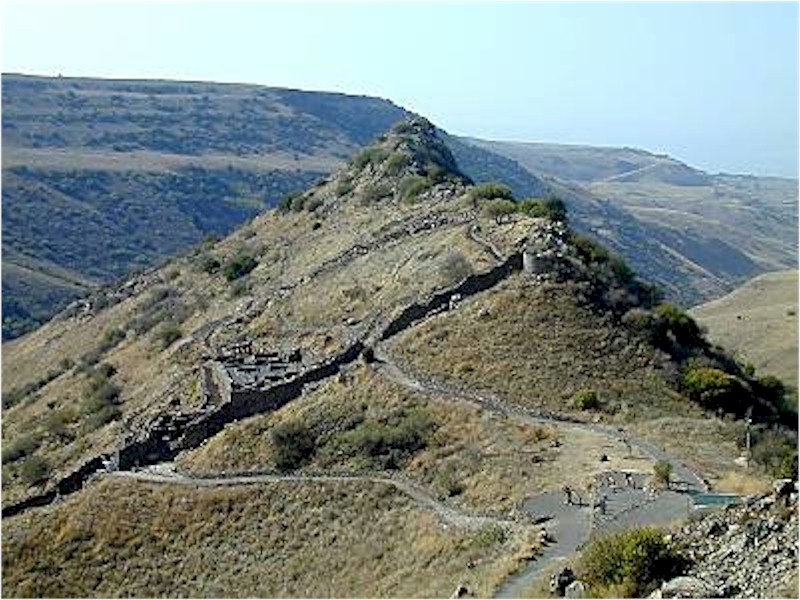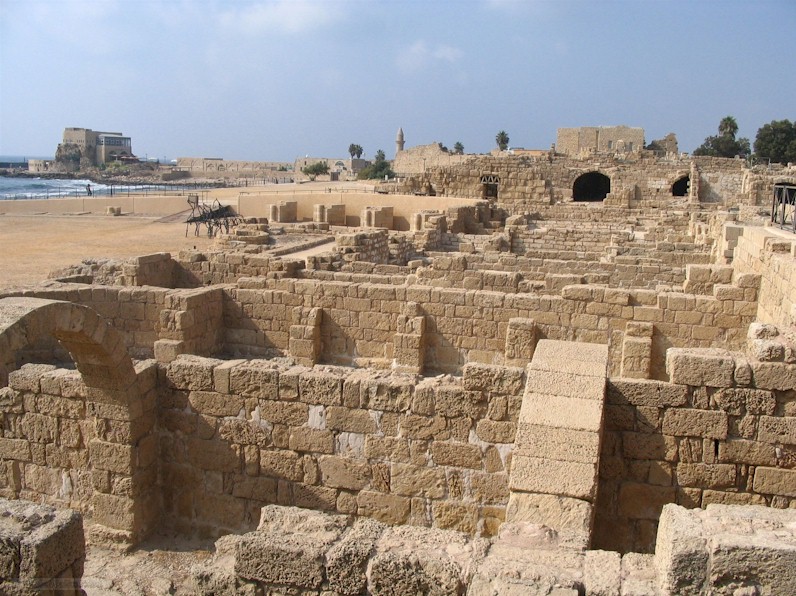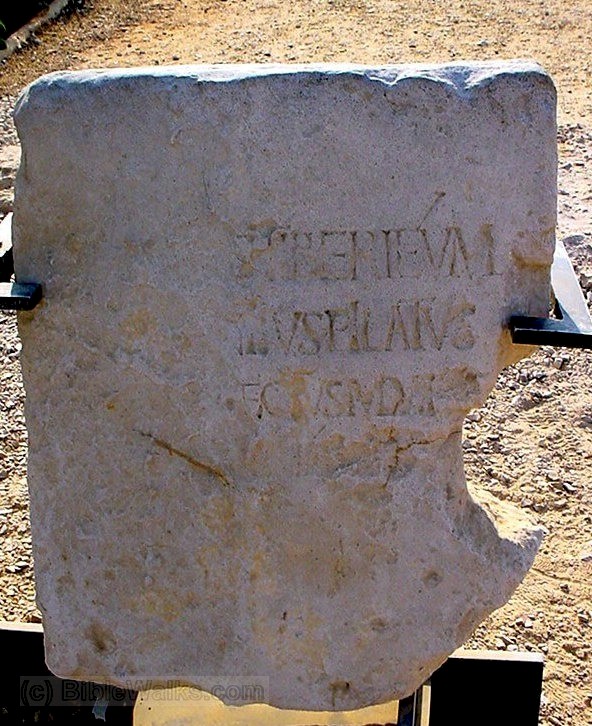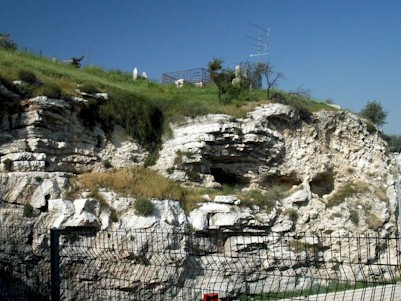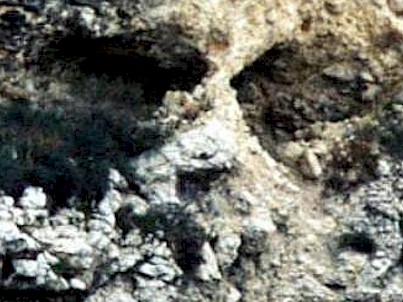2. Pontius Pilate (continued)
English > The novel > Annotations per chapter > Chapter 2 (continued)
Gamala
When Pilate asks him where he comes from, Yeshua does not answer Nazareth, the hometown of the biblical Jesus, nor Betlehem, his birth place. No, he says Gamala, and «indicates with his head that there, somewhere far off to his right, in the north, is the town of Gamala».
Gamala is a town northeast of Tiberias at the Sea of Galilee, which is traditionally not linked to the life of Jesus. None of the four canonical evangelist mention it, so why would Bulgakov do it?
Some historians argue that the absence of textual references to Nazareth in the Old Testament and the Talmud, as well as the works of Flavius Josephus (57-100), suggest that a town called Nazareth did not exist in Jesus' days. They think that Jesus lived in Gamala.
In 1927, the French writer Henry Barbusse (1873-1935) had supported this idea in his book Jésus (Jesus). He had written it because he had felt, as he said it himself, «a strong charm for the human and touching image of the jewish prophet, son of a worker carpenter, who encircled himself with people of modest condition and focussed himself on the humble». Barbusse did not believe in the divinity of Jesus, he believed in his love for mankind. He sympathized with a long time enduring tradition within the working movement: the idea of the revolutionary Jesus, killed by the mighties of the epoch of which he questionned their power. When he published an article called Jesus marxist in the journal L’Humanité to explain himself, many people were scandalized. Later on, Barbusse would write a theatre play called Jésus contre Dieu (Jesus against God) which would never be staged.
Gamala was the homebase of Judas of Galilee who had led a violent resistance against Rome in the year 6 and whose followers, the Zealots, formed a radical anti-Roman group refusing to pay Roman taxes. Jesus recruited his first apostles in the neighbourhood of Gamala. It can not be excluded that among his first followers there were quite some Zealots, even among the apostles. Jacob and John (sons of Zebedee) had sons of the thunder as nicknames, which could refer to the Zealots. It is even possible that Peter was a Zealot. His nickname Bar-jonah (Matthew 16,17) would refer to the Zealots. It means son of Jonah but also outlaw. In Luke 6:15 Simon the Zealot is mentioned among Jesus' closest followers, and maybe Peter's brother Andrew was a Zealot.
Close to Gamala, in Bethsaida, took place one of the two feedings of the multitude, which Jesus Christ would have done. It was the feeding of the 5.000, starting from five barley loaves and two small fish. It was shortly after Jesus had heard that John the Baptist had been killed. The crowd was enthusiastic, as was written in John 6:15: «So Jesus, perceiving that they were intending to come and take Him by force to make Him king, withdrew again to the mountain by Himself alone». After the miracle Jesus sent his apostles away. Matthew 14:22: «Immediately Jesus made the disciples get into the boat and go on ahead of him to the other side, while he dismissed the crowd». Some scholars assume that Jesus sent his apostles away to avoid them to be considered as Zealots by the authorities. This first feeding of the multitude at Bethsaida was described by all four canonical evangelists. A second similar miracle, starting from seven loaves and a few fish, from which a group of 4,000 people were fed, was described only by Mark and Matthew.
In three of the earlier versions of The Master and Margarita, Yeshua said that he was not from Gamala, but from Эн-Назира [En-Nazira], «pointing his hand in the distance». En-Nazira is the Russian transliteration of النَّاصِرَة [an-Nāṣira], the Arabic name for Nazareth. Viktor Ivanovich Losev (°1939), the compiler of My poor poor master, a book in which all saved versions of The Master and Margarita are brought together chronologically, suggests that Bulgakov may have found the name En-Nazira in Life of Christ (1874), a book by Frederic Farrar (1851-1905). But neither Farrar, nor the biblical expert Alexander Pavlovich Lopuchin (1852-1904), who translated Life of Christ into Russian in 1887, mentioned the name En-Nazira in their works.
Bulgakov may have found the name En-Nazira in a work he often used as a source of inspiration while writing The Master and Margarita, namely the Энциклопедический словарь Брокгауза и Ефрона [Entsiklopedesky slovar Brokhauza i Efrona] or the Brockhaus and Efron Encyclopedic Dictionary, a work of 86 volumes, which can be considered as the Russian equivalent for the Encyclopaedia Brittanica. Under the keyword Назарет [Nazaret] it mentions the Arabic name En-Nazira.
In the second-to-last version of the novel, Yeshua said that he was from Эн-Сарид [En-Sarid], and «indicates with his head that there, somewhere far off to his right, in the north, is the town of En-Sarid». That would also indicate Nazareth, according to many Russian philologists, although I have not found any sources confirming it. In the final version of The Master and Margarita En-Sarid became Gamala, but Bulgakov may not have found the time to look at it thoroughly, because in chapter 26 of the final version Yeshua is still described as нищий из Эн-Сарида [nishchni iz En-Sarida] or the beggar from En-Sarid.
A Syrian
Yeshua says: «I don't remember my parents. I was told that my father was a Syrian». Once again, Bulgakov differs significantly from the canonical evangelists who wrote that Jesus' mother, Mary, was still alive when he was executed, so he knew her well when he appeared before Pilate. Maria would have conceived Jesus immaculately, without having had intercourse with her fiance Joseph of Nazareth. Matthew and Luke wrote that Joseph was a descendant of King David (1040BC-970BC) who, according to the Hebrew bible, was the second king of the United Kingdom of Israel. Joseph was a carpenter by profession. He was last time mentioned in the Bible when Jesus was 12 years old. During Jesus' public life, he is not mentioned, leading many to assume that he was already deceased.
According to the Bible, Jesus also had brothers and sisters. His four brothers are mentioned by their names as James, Joseph, Simon and Judas, but his sisters are not named. Only in the apocryphal gospel of Philip is written about «his sister who was called Mary, just like his mother and his companion [Mary Magdalene]». Some Christians who believe in the perpetual virginity of Mary, say that Jesus had no real brothers and sisters, but that they were children born from a previous marriage of Joseph.
Matthew Levi
Many christians believe that the evangelist Matthew is the same person as the apostle Matthew, originally named Levi. It is very doubtful that this is possible, because it would mean that Matthew would have been very old when he wrote his gospel. Most Bible experts estimate the origin of the gospels as follows: Mark circa 65; Luke circa 80-85; Matthew circa 85-90; John circa 90-100. Others date the first three gospels somewhat earlier: Mark shortly after 60; Luke between 60 and 70 and Matthew shortly after 70.
In The Master and Margarita, Jesus and Matthew Levi know each other, but not long enough to speak of an apostle. Bulgakov refers clearly to the evangelist - «one with a goatskin parchment who follows me, follows me and keeps writing all the time», Yeshua says about him.
Bulgakov never mentions the apostles in the novel. Although he makes Aphranius say that, «though we have been unable - so far at least - to discover any admirers or followers of his, it is none the less impossible to guarantee that there are none». But further they have no role, they aren't even mentioned. Just Matthew Levi is called once or twice a «disciple», though it's only by himself. Bulgakov's Matthew Levi has characteristics from both the apostle as the evangelist. He's a tax collector, like the apostle Matthew Levi, and wrote down the acts of Jesus, like the evangelist Matthew.
The apostle Matthew's calling by Jesus was rather controversial. After a conflict with the scribes Jesus left the city and went to the Lake Tiberias also called the Sea of Galilee. Along Capernaum, a town near the lake, was a seaway, the main road from Syria to Egypt. All goods entering Herodes' territory, were taxed at the Capernaum tollbooth, it was one of the four taxes that had to be paid. The tax collectors collected the tolls for the occupying force and often demanded more money than required to keep the rest for themselves. People hated them and they were so despised that their money was not accepted by the Jewish as alms and that their testimony was not legitimated in Jewish courts, because they were ritually unclean by their contacts with heathens. Matthew, called Levi by Mark and Luke, was such tax collector and the fact that Jesus called this man, must have been questionable for many Jews. When Jesus calls him, Matthew leaves his job and his old life behind him and follows Jesus as his disciple. Then they go into Matthew's house and have a festive meal, with Jesus, his disciples and many tax collectors and sinners.
The evangelist Matthew describes the calling of the apostle Matthew as follows: 9:9 - «As Jesus passed on from there, he saw a man named Matthew sitting at the customs post. He said to him, «Follow me».And he got up and followed him».
What is the thruth?
This is a quote from the trial of Jesus by Pilate, as described by the Evangelist John. «What is truth? retorted Pilate. With this he went out again to the Jews gathered there and said, I find no basis for a charge against him» - John 18:38.
The Russian painter Nikolai Nikolaevich Ge (1831-1894) made a painting in 1890 about the meeting of Pilate and Christ, entitled Что есть истина? Христос и Пилат [Shchto yest istina? Khristos i Pilat] or What is the Truth? Christ and Pilate. Ge was a good friend of Lev Nikolaevich Tolstoy (1828-1910), and it is not impossible that Bulgakov knew the painting, although there are no sources to confirm this.
Bethphage
The name Bethfage is Hebrew for house of figs, it is the name of a village near Jerusalem which Jesus passed through on his final journey to Jerusalem.
The gardens on the Mount of Olives
The Mount of Olives is a hill to the east of Jerusalem. At the foot of this hill is Gethsemane, Hebrew for the olive press, just across the stream of Kedron. According to the Gospels it was here that Christ was arrested.
Dysmas, Gestas and Bar-Rabban
Dysmas and Gestas were the thieves crucified together with Jesus. Their names are not given in the canonical Gospels, but found in the apocryphal Gospel of Nicodemus, also known as The Acts of Pilate. Bar-Rabban is the Barabbas from the Gospel who was released by Pilate on the occasion of the feast of Pesach.
The apocryphal Gospel of Nicodemus is downloadable in our archives
Stratonian Caesarea
Pilate's residence was located in Caesarea on the Mediterranean Sea. Caesarea is a city located between Tel Aviv and Haifa, and is often referred to as Caesarea Maritima or Caesarea Palestinae to distinguish it from Caesarea Philippi, a Greco-Roman city in northern Palestine, near the Lebanon border, some 150 kilometers inland.
This distinction is important, because when Bulgakov started writing The Master and Margarita, he believed that Pilate's residence was located in Caesarea Philippi. In the following years, however, he began to have doubts, writing in his notebook: «In which Caesarea did the procurator live? Not in Caesarea Filippova, but in Caesarea Palestine or Caesarea "with the Tower of Straton", on the shores of the Mediterranean Sea».
In the final version of The Master and Margarita, Bulgakov chose the Caesarea with the Tower of Straton, for he wrote Кесария Стратонова на Средиземном [Kesariya Stratonova na Sredizemnom] or Caesarea Stratonova on the Mediterranean Sea. The English translators chose tp translate it as Stratonian Caesarea. Contrary to what one might expect, Stratonova, is not a Latin name. It is Russian and means «from Straton». Initially, Caesarea was a very small settlement with a tower, known in Greek as Πύργος του Στράτωνος [Pirgos toy Stratonos] or Straton Tower, since it was built by Straton I, who was king of the Phoenician city-state of Sidon - today Saïda in Lebanon - 365 to 352 BC. Straton Tower is called in Russian Стратонова Башня [Stratonova bashiya], hence the name Caesarea Stratonova.
Around the year 20 BC, Herod the Great (?75BC-04) started expanding the settlement, calling it Caesarea, in honour of the Roman emperor. When Judea became a Roman province in the year 6, the Roman prefects and later the procurators chose Caesarea as their residence. They used Herod's palace as a praetorium. Pontius Pilate had a temple built in Caesarea in honour of Emperor Tiberius (42BC-37). In this temple the so-called Stone of Pilate has been found, a rock with the inscription «...us Pilatus».
Yehuda of Kiriath
Bulgakov's Judas is quite different from Judas in the Bible. In the New Testament Judas is one of the twelve apostles, and he knows Jesus much longer than just two days. The apostles accompanied Jesus of Nazareth for three years. In the Bible Judas is not killed - he committed suicide, driven by remorse and regret. After his death he was replaced in the group of 12 apostles by Matthias. Bulgakov made him a spy, driven by money and somewhat by love too.
Lit the lamps
With his observation on «litting the lamps» Pilate wanted to tease Yeshua because he had not understood that litting the lamps was a sign. Lights were lit so that the concealed witnesses for the accusation could see the face of the criminal. Yeshua was slightly surprised that «the procurator was so well informed», as if he did not realise that he was betrayed.
Bald Mountain
Bald Mountain is the place which in the Gospels is called Golgotha - an Aramaic word meaning Place of the skulls - and where Jesus was crucified. Topographically Bulgakov’s hill is higher than Golgotha and farther from the city. There is also a Bald Mountain near Bulgakov's native city Kyiv in Ukraine.
Joseph Kaifa
The Sanhedrin had no direct authority to sentence to death except in case of desecration of the temple. That's why their death penalty for Jesus of Nazareth had to be ratified by Pilate. The Sanhedrin was presided by the high priest. The historical Joseph Caiaphus was appointed to that function by Pilate's predecessor, Valerius Gratus, in the year 18.
Kaifa politely apologised
Pilate invited Kaifa on to the balcony, to take shelter from the merciless heat, but «Kaifa politely apologized». According to a Jewish belief, going under the roof of a gentile would have made the high priest unclean and therefore unable to celebrate the coming feast.
Pilate himself began moving with them
This is possibly a hint to the legend according to which Pilate died by drowning himself.
Equestrian of the Golden Spear
The Knights of the Golden Spear was an equestrian order of Roman nobility. The order was next in importance to the Senate. Emperor Augustus (63 BC-14) reformed the order, after which it supplied occupants for many administrative posts. The name Pilate (Pilatus) may be derived from pilum, Latin for spear.
Previous page Annotations chapter 2
Share this page |
Chapters
- Introduction
- 1 Never Talk with Strangers
- 2 Pontius Pilate
- 3 The Seventh Proof
- 4 The Chase
- 5 There were Doings at Griboedov's
- 6 Schizophrenia, as was Said
- 7 A Naughty Apartment
- 8 The Combat between the Professor...
- 9 Koroviev's Stunts
- 10 News From Yalta
- 11 Ivan Splits in Two
- 12 Black Magic and Its Exposure
- 13 The Hero Enters
- 14 Glory to the Cock!
- 15 Nikanor Ivanovich's Dream
- 16 The Execution
- 17 An Unquiet Day
- 18 Hapless Visitors
- 19 Margarita
- 20 Azazello's Cream
- 21 Flight
- 22 By Candlelight
- 23 The Great Ball at Satan's
- 24 The Extraction of the Master
- 25 How the Procurator Tried...
- 26 The Burial
- 27 The End of Apartment No. 50
- 28 The Last Adventures of Koroviev...
- 29 The Fate of the Master and...
- 30 It's Time! It's Time!
- 31 On Sparrow Hills
- 32 Forgiveness and Eternal Refuge
- Epilogue
English subtitles

All films based on The Master and Margarita are subtitled in English, French, German, Dutch, Spanish and Italian.
